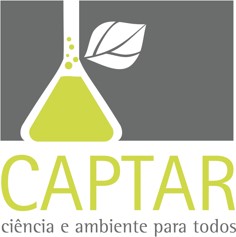Relação entre a disponibilidade de ferro (Fe2+) e a capacidade de sequestração de CO2 pela espécie <i>Tetraselmis chuii<i/>
Resumo
O ferro provou ser um elemento fulcral para o balanço biogeoquímico da produtividade primária da zona eufótica dos oceanos. Estudos de “fertilização” em ferro que procuraram estabelecer esta relação foram conduzidos preferencialmente em meso- e macro- escala, embora experiências de pequena escala reflitam com rigor os processos que ocorrem in situ. Neste sentido, foi estudada a resposta da microalga Tetraselmis chuii a diferentes concentrações de Ferro (Fe2+), cultivando-a em três grupos experimentais: controlo (meio F/2), II (F/2 + 2x Fe2+) e III (F/2 + 4x Fe2+). Foi calculado o peso seco permitiu a determinação da biomassa algal (ma, gL-1) e da massa de carbono inorgânico sequestrado (mCi, gL-1).
Comparativamente ao controlo (ma=(1,7±0,58), mCi=0,85), o Grupo II (ma=(2,6±0,58), mCi=1,3) e particularmente o III (ma=(4,0±1,0), mCi=2,0) verificou-se uma diferença estatisticamente significativa na produção de biomassa e na sequestração de carbono.
O presente estudo permitiu demonstrar a existência de um maior crescimento algal em culturas expostas a uma maior disponibilidade de Fe, concluindo que a sequestração de CO2 é potenciada usando concentrações crescentes daquele metal. Investigações subsequentes deverão procurar compreender a influência da adubação em ferro na proliferação de outras espécies, nomeadamente no que se refere aos harmful algal blooms (HBAs).
Referências
Anderson RA, Berges JA, Harrisson PJ, Watanable MM (2005). Recipes for freshwater and seawater media. In: RA Anderson (ed.), Algal culturing techniques. Elsevier Academic Press, Amsterdam, pp. 429-538.
Aumont O, Bopp L (2006). Globalizing results from ocean in situ iron fertilization studies. Global Biogeochem. Cycles 20: 1-15.
Barsanti, L., & Gualtieri, P. (2014). Algae: anatomy, biochemistry, and biotechnology. 2nd edition. CRC press. Boca Raton.
Borowitzka MA, Beardall J, Raven JA (2016). Algal physiology and Large-Scale Outdoor Cultures of Microalgae. In: Borowitzka MA, Beardall J, Raven JA (eds.), The physiology of microalgae. Springer International Publishing, Switzerland, p. 625.
Botebol H et. al. (2013) Different iron sources to study the physiology and biochemistry of iron metabolism in marine micro-algae. Biology of Metals 27(1).
Boyd PW et. al. (2004). The decline and fate of an iron-induced subarctic phytoplankton bloom. Nature 428: 549-553.
Buesseler KO, Boyd PW (2003). Will ocean fertilization work? Science 300: 67-68.
Coale KH et. al. (1996). A massive phytoplankton bloom induced by ecosystem-scale iron fertilization experiment in the equatorial Pacific Ocean. Nature 383: 495-501.
Coale KH. et. al. (2004). Southern Ocean Iron Enrichment Experiment: Carbon cycling in high- and low-Si water. Science 304: 408-414.
Crisholm SW et. al. (2001). Dis-crediting ocean fertilization. Science 294: 309-310.
Geider RJ, La Roche J (1994). The role of iron in phytoplankton photosynthesis, and the potential for iron-limitation of primary productivity in the sea. Photosynthesis Res. 39: 275-301.
Gervais F et. al. (2002). Changes in primary productivity and chorophyll a in response to iron fertilization in the Southern Polar Frontal Zone. Limnol. Oceanogr. 47:1324-1335.
Gnanadesikan A et. al. (2003). Effects of patchy ocean fertilization on atmospheric carbon dioxide and biological production. Global Biogeochem. Cycles 17(2):1050.
Gribbin J (1998). Any old iron? Nature 331:570.
Guillard RRL (1975). Culture of phytoplankton for feeding marine invertebrates. In: Smith WL, Chanley MH (eds.), Culture of Marine Invertebrate Animals. Plenum Press, New York, pp. 26-60.
Guillard RRL, Ryther JH (1962). Studies of marine planktonic diatoms - Cyclotella nana Hustedt and Detonula confervacea Cleve. Can. J. Microbiol. 8:229-239.
Herzog H, Golomb D (2004). Carbon capture and storage from fossil fuel use. Encyclopedia of Energy 1:1–11.
Jin X, Gruber N (2003). Offsetting the radiative benefit of ocean iron fertilization by enhancing N2O emissions. Geophys. Res. Lett. 30(24): 224.
Kadar E et. al. (2012). The effect of engineered iron nanoparticles on growth and metabolic status of marine microalgae cultures. Science of The Environment 439:8-17.
Martin JH el. Al (1994). Testing the iron hypothesis in ecosystems of the equatorial Pacific Ocean. Nature 371:123-129.
Martin JH et. al. (1990). Iron deficiency limits phytoplankton growth in Antarctic water. Global Biogeochem. Cycles 4:5-12.
Richmond A (2004). Handbook of Microalgal Culture. Biotechnology and Applied Phycology. Blackwell Publishing Ltd., Oxford, pp. 97-115.
Rukminasari, N. et. al. (2019). Effects of increasing temperature and nitrate concentration on cell abundance, growth rate, biomass and free fatty acid of Tetraselmis sp. IOP Conf., Ser.: Earth Environ. Sci. 370 012059.
Sarmiento JL, Orr JC (1991). Three-dimensional simulations of the impact of Southern Ocean nutrient depletion on atmospheric CO2 and ocean chemistry. Limnol. Oceanogr. 36:1928-1950.
Sayre R (2013). The Potential for Carbon Capture. BioScience 60(9):722-727.
Tsuda A et. al. (2003). A mesoscale iron enrichment in the western subarctic Pacific induces a large centric diatom bloom. Science 300:958-961.
UTEX, (2021). Culture Collection of Algae at the University of Texas at Austin, acedido a 10 março 2012, em https://utex.org/products/utex-lb-0232?variant=30992157179994.
Direitos de Autor (c) 2021 Diogo Rosa Heleno, Beatriz Almeida Fernandes, Joana Espírito Santo Couto, Rui P. Fernandes, Teresa Mouga

Este trabalho está licenciado com uma Licença Creative Commons - Atribuição 4.0 Internacional.







